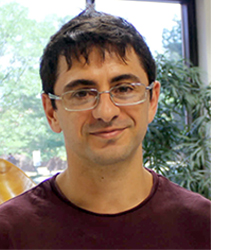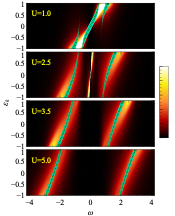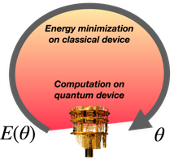Lanatà Research
Contact
Dr. Nicola Lanatà
Assistant Professor
College of Science
School of Physics and Astronomy
nxlsps@rit.edu
About Dr. Nicola Lanatà
 Nicola Lanatà is a tenure-track assistant professor at the RIT School of Physics and Astronomy and a Visiting Scholar at the Center for Computational Quantum Physics (CCQ) in New York. A physicist with a Ph.D. in “Theory and Numerical Simulation in Condensed Matter Systems” from the International School for Advanced Studies (SISSA-ISAS), Dr. Lanatà has held several research positions, including a “Dirac Fellowship” at the National High Magnetic Field Laboratory and assistant professor positions at Aarhus University in Denmark and NORDITA in Sweden.
Nicola Lanatà is a tenure-track assistant professor at the RIT School of Physics and Astronomy and a Visiting Scholar at the Center for Computational Quantum Physics (CCQ) in New York. A physicist with a Ph.D. in “Theory and Numerical Simulation in Condensed Matter Systems” from the International School for Advanced Studies (SISSA-ISAS), Dr. Lanatà has held several research positions, including a “Dirac Fellowship” at the National High Magnetic Field Laboratory and assistant professor positions at Aarhus University in Denmark and NORDITA in Sweden.
Dr. Lanatà’s research interests lie in the study of the quantum-mechanical properties of strongly correlated materials, such as their electronic structure, energy, chemical, and spectral properties. He utilizes many-body techniques and machine-learning methods to model and simulate these properties in a more accurate and efficient manner. The goal is to make ab-initio modeling and theory-driven design of strongly correlated materials accessible to various disciplines, including condensed matter physics, materials science, chemistry, and biochemistry.
Research Opportunities for MS Students!
Current Research
 We are seeking a highly motivated MS student to join our team at the RIT School of Physics and Astronomy under the supervision of Dr. Nicola Lanatà. Our research project aims to develop a method for accurately and efficiently computing the properties of strongly correlated materials using quantum mechanics principles and models. These materials are of great interest in fields such as condensed matter physics, materials science, and chemistry, due to their complex behavior that cannot be explained by traditional methods.
We are seeking a highly motivated MS student to join our team at the RIT School of Physics and Astronomy under the supervision of Dr. Nicola Lanatà. Our research project aims to develop a method for accurately and efficiently computing the properties of strongly correlated materials using quantum mechanics principles and models. These materials are of great interest in fields such as condensed matter physics, materials science, and chemistry, due to their complex behavior that cannot be explained by traditional methods.
This is an opportunity to learn about the application of quantum mechanics principles and models to real material applications and to contribute to the development of a cutting-edge method for studying these materials. You will work with a team of experienced researchers, and have the opportunity to collaborate with colleagues at Rutgers University and the Center for Computational Quantum Physics (CCQ). Your responsibilities will include implementing and testing the method using simple systems such as the Hubbard model and then progressing to more complex systems in the second phase.
The project utilizes the ghost Gutzwiller Approximation (g-GA) method in combination with density functional theory to study these materials. We will also be testing the Gutzwiller renormalization group as an impurity solver, for improving the accuracy and computational efficiency of the g-GA. The goal is to improve our understanding of strongly correlated materials and unlock new possibilities for their study.
For students interested in working on a project with the potential to significantly advance the field of strongly correlated quantum matter, contact Dr. Nicola Lanatà.
 We are seeking a highly motivated MS student to join our team at the RIT School of Physics and Astronomy under the supervision of Dr. Nicola Lanatà. Our research project aims to develop a method for accurately and efficiently simulating quantum-mechanical systems using a hybrid quantum-classical framework called Variational Quantum Eigensolver (VQE). These algorithms have the potential to enable broader applications in fields such as condensed matter physics, chemistry, and materials science, but are currently limited by noise from decoherence and hardware imperfections.
We are seeking a highly motivated MS student to join our team at the RIT School of Physics and Astronomy under the supervision of Dr. Nicola Lanatà. Our research project aims to develop a method for accurately and efficiently simulating quantum-mechanical systems using a hybrid quantum-classical framework called Variational Quantum Eigensolver (VQE). These algorithms have the potential to enable broader applications in fields such as condensed matter physics, chemistry, and materials science, but are currently limited by noise from decoherence and hardware imperfections.
This is an opportunity to contribute to cutting-edge research at the forefront of the field by using probabilistic machine learning to mitigate this noise in VQE algorithms. This will improve the reliability of quantum computing and unlock new possibilities for simulations of large molecules and solids. Your responsibilities will include developing and testing the probabilistic machine learning method for noise mitigation in VQE, as well as applying this method to quantum computing devices.
You will work with a team of experienced researchers, and have the opportunity to contribute to the development of a cutting-edge method for studying the quantum matter. If you are passionate about exploring the potential of quantum computing and machine learning and are interested in working on a project with the potential to significantly advance the field, contact Dr. Nicola Lanatà.
Publications
[1] Tsung-Han Lee, Nicola Lanatà and Gabriel Kotliar, “Accuracy of ghost-rotationally-invariant slave-boson and dynamical mean field theory as a function of the impurity-model bath size”, Phys. Rev. B 107, L121104 (2023).
[2] Alla Chikina, Gargee Bhattacharyya, Davide Curcio, Charlotte E. Sanders, Marco Bianchi, Nicola Lanatà, Matthew Watson, Cephise Cacho, Martin Bremholm and Philip Hofmann, “One-dimensional electronic states in a natural misfit structure”, Phys. Rev. Materials 6, L092001 (2022).
[3] Nicola Lanatà, “Operatorial formulation of the ghost rotationally-invariant slave-Boson theory”, Phys. Rev. B 105, 045111 (2022).
[4] Alfred J. H. Jones, Ryan Muzzio, Sahar Pakdel, Deepnarayan Biswas, Davide Curcio, Nicola Lanatà, Philip Hofmann, Kathleen M. McCreary, Berend T. Jonker, Kenji Watanabe, Takashi Taniguchi, Simranjeet Singh, Roland J. Koch, Chris Jozwiak, Eli Rotenberg, Aaron Bostwick, Jill A. Miwa, Jyoti Katoch and Søren Ulstrup, “Visualizing band structure hybridization and superlattice effects in twisted MoS2/WS2 heterobilayers”, 2D Mater. 9, 015032 (2022).
[5] Tsung-Han Lee, Nicola Lanatà, Minjae Kim and Gabriel Kotliar, “Efficient Slave-Boson Approach for Multiorbital Two-Particle Response Functions and Superconductivity”, Phys. Rev. X 11, 041040 (2021).
[6] Davide Curcio, Sahar Pakdel, Klara Volckaert, Jill A. Miwa, Søren Ulstrup, Nicola Lanatà, Marco Bianchi, Dmytro Kutnyakhov, Federico Pressacco, Günter Brenner, Siarhei Dziarzhytski, Harald Redlin, Steinn Agustsson, Katerina Medjanik, Dmitry Vasilyev, Hans-Joachim Elmers, Gerd Schönhense, Christian Tusche, Ying-Jiun Chen, Florian Speck, Thomas Seyller, Kevin Bühlmann, Rafael Gort, Florian Diekmann, Kai Rossnagel, Yves Acremann, Jure Demsar, Wilfried Wurth, Daniel Lizzit, Luca Bignardi, Paolo Lacovig, Silvano Lizzit, Charlotte E. Sanders and Philip Hofmann, “Ultrafast electronic line width broadening in the C 1s core level of graphene”, Phys. Rev. B 104, L161104 (Letter) (2021).
[7] Marius S. Frank, Tsung-Han Lee, Gargee Bhattacharyya, Pak Ki Henry Tsang, Victor L. Quito, Vladimir Dobrosavljević, Ove Christiansen and Nicola Lanatà, “Quantum-embedding description of the Anderson lattice model with the ghost Gutzwiller Approximation”, Phys. Rev. B 104, L081103 (Letter) (2021).
[8] Paulina Majchrzak, Sahar Pakdel, Deepnarayan Biswas, Alfred J. H. Jones, Klara Volckaert, Igor Marković, Federico Andreatta, Raman Sankar, Chris Jozwiak, Eli Rotenberg, Aaron Bostwick, Charlotte E. Sanders, Yu Zhang, Gabriel Karras, Richard T. Chapman, Adam Wyatt, Emma Springate, Jill A. Miwa, Philip Hofmann, Phil D. C. King, Nicola Lanatà, Young Jun Chang, Søren Ulstrup, “Switching of the electron-phonon interaction in 1T-VSe2 assisted by hot carriers”, Phys. Rev. B 103, L241108 (Letter) (2021).
[9] Ann Julie U. Holt, Sahar Pakdel, Jonathan Rodríguez-Fernández, Yu Zhang, Davide Curcio, Zhaozong Sun, Paolo Lacovig, Yong-Xin Yao, Jeppe V. Lauritsen, Silvano Lizzit, Nicola Lanatà, Philip Hofmann, Marco Bianchi and Charlotte E. Sanders, “Electronic Properties of Single-Layer CoO2/Au(111)”, 2D Mater. 8, 035050 (2021).
[10] Umut Kamber, Sahar Pakdel, Raluca-Maria Stan, Anand Kamlapure, Brian Kiraly, Fabian Arnold, Andreas Eich, Arlette S. Ngankeu, Marco Bianchi, Jill A. Miwa, Charlotte E. Sanders, Nicola Lanatà, Philip Hofmann and Alexander A. Khajetoorians, “Moiré induced electronic structure in monolayer V2S3 on Au(111)”, Phys. Rev. B 103, 115414 (2021).
[11] Deepnarayan Biswas, Alfred J. H. Jones, Paulina Majchrzak, Byoung Ki Choi, Tsung-Han Lee, Klara Volckaert, Jiagui Feng, Igor Marković, Federico Andreatta, Chang-Jong Kang, Hyuk Jin Kim, In Hak Lee, Chris Jozwiak, Eli Rotenberg, Aaron Bostwick, Charlotte E. Sanders, Yu Zhang, Gabriel Karras, Richard T. Chapman, Adam S. Wyatt, Emma Springate, Jill A. Miwa, Philip Hofmann, Phil D. C. King, Young Jun Chang, Nicola Lanatà and Søren Ulstrup “Ultrafast triggering of insulator-metal transition in two-dimensional VSe2”, Nano Lett. 21, 1968 (2021).
[12] John Rogers, Tsung-Han Lee, Sahar Pakdel, Wenhu Xu, Vladimir Dobrosavljević, Yong-Xin Yao, Ove Christiansen, and Nicola Lanatà, “Bypassing the computational bottleneck of quantum-embedding theories for strong electron correlations with machine learning”, Phys. Rev. Research 3, 013101 (2021).
[13] Nicola Lanatà, “Local bottom-up effective theory of non-local electronic interactions”, Phys. Rev. B 102, 115115 (2020).
[14] Alfred J. H. Jones, Ryan Muzzio, Paulina Majchrzak, Sahar Pakdel, Davide Curcio, Klara Volckaert, Deepnarayan Biswas, Jacob Gobbo, Simranjeet Singh, Jeremy T. Robinson, Kenji Watanabe, Takashi Taniguchi, Timur K. Kim, Cephise Cacho, Nicola Lanatà, Jill A. Miwa, Philip Hofmann, Jyoti Katoch and Søren Ulstrup, “Observation of Electrically Tunable van Hove Singularities in Twisted Bilayer Graphene from NanoARPES”, Adv. Mater. 32, 2001656 (2020).
[15] Garry Goldstein, Nicola Lanatà and Gabriel Kotliar, “Extending the Gutzwiller approximation to intersite interactions”, Phys. Rev. B 102, 045152 (2020).
[16] Klara Volckaert, Habib Rostami, Deepnarayan Biswas, Igor Marković, Federico Andreatta, Charlotte E. Sanders, Paulina Majchrzak, Cephise Cacho, Richard T. Chapman, Adam Wyatt, Emma Springate, Daniel Lizzit, Luca Bignardi, Silvano Lizzit, Sanjoy K. Mahatha, Marco Bianchi, Nicola Lanatà, Philip D. C. King, Jill A. Miwa, Alexander V. Balatsky, Philip Hofmann and Søren Ulstrup, “Momentum-resolved linear dichroism in bilayer MoS2”, Phys. Rev. B 100, 241406 (Rapid Communications) (2019).
[17] Habib Rostami, Klara Volckaert, Nicola Lanatà, Sanjoy K. Mahatha, Charlotte E. Sanders, Marco Bianchi, Daniel Lizzit, Luca Bignardi, Silvano Lizzit, Jill A. Miwa, Alexander V. Balatsky, Philip Hofmann and Søren Ulstrup, “Layer and orbital interference effects in photoemission from transition metal dichalcogenides”, Phys. Rev. B 100, 235423 (2019).
[18] Justin N. Cross, Tsung-Han Lee, Chang-Jong Kang, Yong-Xin Yao, Samantha K. Cary, Jared T. Stritzinger, Matthew J. Polinski, Carla D. McKinley, Thomas E. Albrecht-Schmitt and Nicola Lanatà, “Origins of the Odd Optical Observables in Plutonium and Americium Tungstates”, Chem. Sci., 10, 6508 (2019).
[19] Nicola Lanatà, Tsung-Han Lee, Yong-Xin Yao, Vladan Stevanovic and Vladimir Dobrosavljević, “Connection between Mott physics and crystal structure in a series of transition metal binary compounds”, NPJ Comput. Mater. 5: 30 (2019).
[20] Tsung-Han Lee, Thomas Ayral, Yong-Xin Yao, Nicola Lanatà and Gabriel Kotliar, “Rotationally invariant slave-boson and density matrix embedding theory: A unified framework and a comparative study on the 1D and 2D Hubbard Model” Phys. Rev. B 99, 115129 (2019).
[21] Shane S. Galley, Alexandra A. Arico, Tsung-Han Lee, Xiaoyu Deng, Yong-Xin Yao, Joseph M. Sperling, Vanessa Proust, Julia S. Storbeck, Vladimir Dobrosavljevic, Jennifer N. Neu, Theo Siegrist, Ryan E. Baumbach, Thomas E. Albrecht-Schmitt, Nikolas Kaltsoyannis, and Nicola Lanatà, “Uncovering the Origin of Divergence in the CsM(CrO4)2 (M = La ‒ Sm; Am) Family through the Chemical Bonding in a Molecular Cluster and by Band Structure Analysis”, J. Am. Chem. Soc. (JACS) 140, 1674-1685 (2018).
[22] Nicola Lanatà, Tsung-Han Lee, Yong-Xin Yao, and Vladimir Dobrosavljević, “Emergent Bloch Excitations in Mott Matter”, Phys. Rev. B 96, 195126 (2017).
[23] Nicola Lanatà, Yong-Xin Yao, Xiaoyu Deng, Vladimir Dobrosavljević and Gabriel Kotliar, “Slave Boson Theory of Orbital Differentiation with Crystal Field Effects: Application to UO2”, Phys. Rev. Lett. 118, 126401 (2017).
[24] Nicola Lanatà, Yong-Xin Yao, Xiaoyu Deng, Cai-Zhuang Wang, Kai-Ming Ho and Gabriel Kotliar, “Gutzwiller Renormalization Group”, Phys. Rev. B 93, 045103 (2016).
[25] Nicola Lanatà, Xiaoyu Deng and Gabriel Kotliar, “Finite-Temperature Gutzwiller Approximation from Time-Dependent Variational Principle”, Phys. Rev. B (Rapid Communications) 92, 081108(R) (2015).
[26] Nicola Lanatà, Yong-Xin Yao, Cai-Zhuang Wang, Kai-Ming Ho, and Gabriel Kotliar, “Phase Diagram and Electronic Structure of Praseodymium and Plutonium”, Phys. Rev. X 5, 011008 (2015).
[27] Nicola Lanatà, Yong-Xin Yao, Cai-ZhuangWang, Kai-Ming Ho and Gabriel Kotliar, “Interplay of spin-orbit and entropic effects in Cerium”, Phys. Rev. B (Rapid Communications) 90, 161104(R) (2014).
[28] Nicola Lanatà, Hugo U. R. Strand, Yong-Xin Yao and Gabriel Kotliar, “Principle of Maximum Entanglement Entropy and local physics of Strongly Correlated Materials”, Phys. Rev. Lett. 113, 036402 (2014).
[29] Nicola Lanatà, Yong-Xin Yao, Cai-Zhuang Wang, Kai-Ming Ho, Jörg Schmalian, Kristjan Haule and Gabriel Kotliar, “g-a isostructural Transition in Cerium”, Phys. Rev. Lett. 111, 196801 (2013).
[30] Nicola Lanatà, Hugo U. R. Strand, Gianluca Giovannetti, Bo Hellsing, Luca de' Medici and Massimo Capone, “Orbital Selectivity in Hund's metals: The Iron Chalcogenides”, Phys. Rev. B 87, 045122 (2013).
[31] Nicola Lanatà and Hugo U. R. Strand, “Time-dependent and steady-state Gutzwiller approach for nonequilibrium transport in nanostructures”, Phys. Rev. B, 86, 115310 (2012).
[32] Nicola Lanatà, Hugo U. R. Strand, Xi Dai, and Bo Hellsing, “Efficient implementation of the Gutzwiller variational method”, Phys. Rev. B, 85, 035133 (2012).
[33] Nicola Lanatà, “Variational approach to transport in quantum dots”, Phys. Rev. B 82, 195326 (2010). Selected for the November 29, 2010 issue of Virtual Journal of Nanoscale Science & Technology.
[34] Nicola Lanatà, Paolo Barone and Michele Fabrizio, “Superconductivity in the doped bilayer Hubbard model”, Phys. Rev. B, 80, 224524 (2009).
[35] Nicola Lanatà, Paolo Barone and Michele Fabrizio, “Fermi-surface evolution across the magnetic phase transition in the Kondo lattice model”, Phys. Rev. B 78, 155127 (2008).




